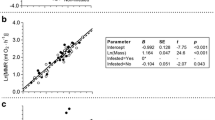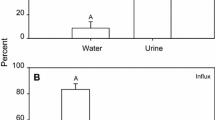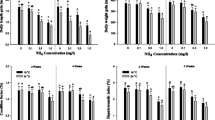Abstract.
The subtidal crab Cancer pagurus (L.) experiences involuntary periods of emersion associated with practices used in their marketing and distribution. During 24 h emersion, impaired gill function caused an increase of circulating total ammonia (TA=NH3+NH4 +) of 0.35 mmol TA l–1 (167%). The oxygen-binding characteristics of the haemocyanin of C. pagurus were examined at 10°C in the presence of total ammonia (0.2–1.0 mmol TA l–1). The haemocyanin–oxygen affinity was decreased in the presence of TA (ΔlogP 50/Δlog[TA]=0.16). Emersion induced significant acidosis and elevated circulating levels of haemolymph TA, lactate and urate, but all had returned to normal levels within 24 h of re-immersion. The accumulation of haemocyanin-modulating substances during 24 h emersion compensated partially (40%) for the effect of the acidosis, but the net effect of the emersion period was a significant decrease in oxygen affinity, corresponding to an increase of P 50 (10°C ) from 1.24 kPa (immersed) to 1.96 kPa (24 h emersion). The implications of the findings are considered in terms of the effects and adaptations to emersion.
Similar content being viewed by others
Author information
Authors and Affiliations
Additional information
Electronic Publication
Rights and permissions
About this article
Cite this article
Danford, .A., Hagerman, .L. & Uglow, .R. Effects of emersion and elevated haemolymph ammonia on haemocyanin–oxygen affinity of Cancer pagurus . Marine Biology 141, 1019–1027 (2002). https://doi.org/10.1007/s00227-002-0906-6
Received:
Accepted:
Issue Date:
DOI: https://doi.org/10.1007/s00227-002-0906-6




